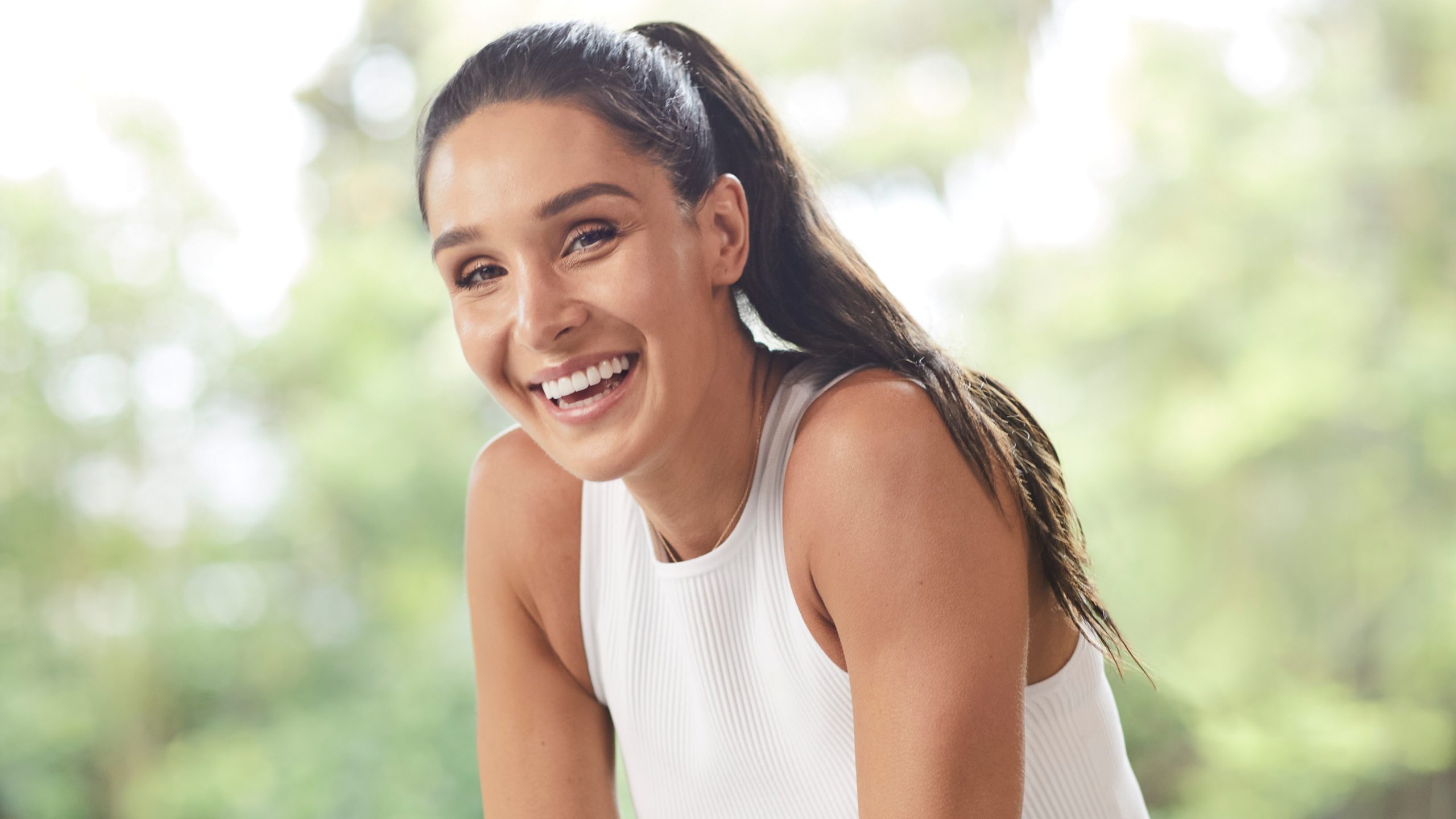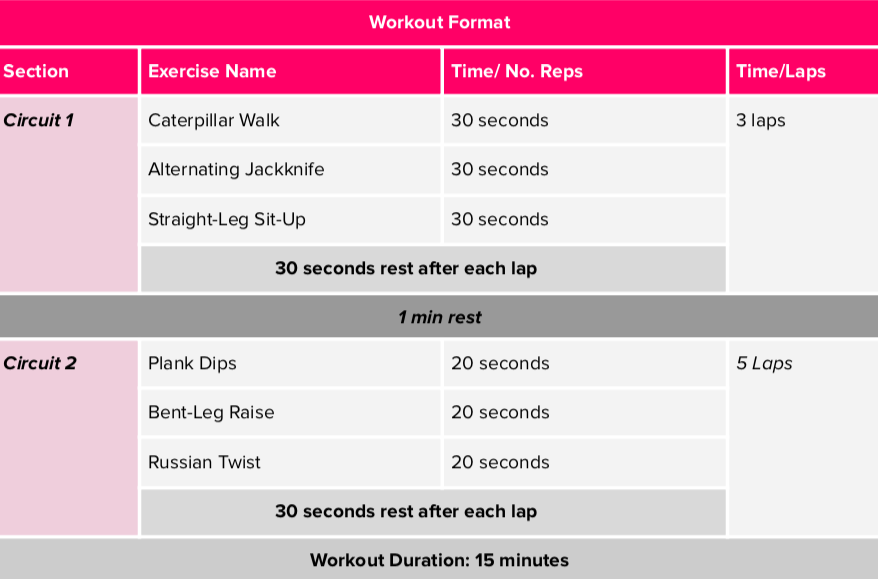
Scroll for an exclusive workout from the world famous PT, to boot.
You've likely done your fair share of running, HIIT workouts and strength training in your time (not to mention some questionable celebrity workouts), but world-renowned PT Kayla Itsines reckons it's time you tried a new type of sweat session—that is, low impact workouts for beginners.
Lucky for you, last year Itsines launched a new low impact programme on her app, SWEAT. The aim? To make fitness more achievable for women everywhere.
The PT is known for her love of high intensity training - so why the pivot to a lower impact offering? Simply put, because you can get just as good results from low impact as high impact, and the idea that HIIT is the only way to get super fit needs to change.
That's why, from this week, Itsines' global community of over 50 million women who use SWEAT to train will now be offered low impact options, too.
Every body is different, and she wants to highlight that low impact can be just as effective for boosting your general fitness and wellbeing.
Ready to learn all about what low impact workouts are, why a low impact, low intensity workout without jumping or burpees might be the best workout for you, and why they can be just as effective a workout option?
Itsines is on hand to answer all your questions, and has a low impact workout for beginners for you, to boot.
Celebrity news, beauty, fashion advice, and fascinating features, delivered straight to your inbox!
Keep scrolling.
Introducing Itsines' new low impact workout offering
What are low impact workouts?
Low impact workouts are sweat sessions designed to reduce pressure on your joints, shares Itsines.
"Normally this is by substituting plyometric exercises, like jump squats and burpees, with exercises that ensure you are either fully supported or have at least one foot in contact with the ground at all times," she explains.
Got it?
Who are low impact workouts best for?
Anyone, really, but in particular, "low impact workouts are great for anyone who is unable to jump due to discomfort or who doesn’t like high impact movements," explains Itsines.
This adds to the misconception that high impact exercise is in some way 'superior' to low, when infact, they're still a great workout to build strength and tone—but more on that below.
What are the main benefits of low impact workouts?
Onto the benefits of low impact workouts - there are a lot. "You can improve upper body strength, balance, cardiovascular endurance and lower body strength," she shares. Why? Well, as these exercises cause less strain on your body and joints, reducing the risk of injury compared to a high impact exercise like a jump squat.
Why is reducing your risk of injury important? Simply because you're probably more at risk of injury day-to-day than you may think. "Women’s lives are busy and often things like stress, anxiety, poor sleep or inadequate nutrition impact how well someone can recover from a strenuous workout," shares Itsines.
Bottom line: Listening to your body is so important and low impact workouts are great for women who want to workout without high intensity jumping exercises, allowing faster recovery, she explains.

Can I get as fit from low impact workouts?
Another common misconceptions is that low impact movements aren't as effective as burpees and jump squats, but this isn't correct.
Short answer: you can get as fit. "All of my low impact workouts build and strengthen your muscles and enhance your physical fitness throughout a range of functional movements to help keep you moving forward on your fitness journey," she shares.
Low impact workouts for beginners: a Kayla-approved SWEAT session to try tonight
Ready to get your heart-rate up without a burpee in sight? Let Kayla guide you through this low impact ab workout.
Length? 15 minutes.
Why? This workout can help to improve the strength and stamina of the muscles in your core including your deep abdominals and obliques.
Try this: Do the first three moves, for 30 seconds at a time. Rest for 30 seconds, and repeat three times. Then, move on to the second three exercises. Do each for 30 seconds, then rest for 30 seconds, and repeat five times.

Warm up
Try three to five minutes of cardio, such as jogging in place or skipping. "This will help increase your heart rate and warm up your muscles for your session," she shares.
Move 1: Caterpillar Walk
a. Plant both feet on the floor shoulder-width apart. Looking straight ahead, bend at both the hips and knees, and place your hands on the floor directly in front of your feet. This is your starting position.
b. Inhale. Without moving your feet, walk your hands forward until your body is in one straight line from your head to your heels, resting on the balls of your feet.
c. Exhale. Jump both of your feet forwards in between your hands, ensuring that your feet remain shoulder-width apart, to return to the starting position. Repeat for the specified number of repetitions.
Move 2: Alternating Jackknife
a. Start by lying straight on your back on a yoga mat with your legs extended out in front of you. Bend your elbows and place your hands behind your earlobes. Gently raise both legs and your head and shoulders off the mat. This is your starting position.
b. While keeping your right leg extended, elevate your left leg so that it is at a 90-degree angle to your hips. At the same time, extend your right arm to bring your hand up towards your left foot— slowly lifting your head, shoulder blades and torso off the mat.
c. Lower your torso, shoulder blades and head to the mat. Lower your left leg and place your right hand behind your earlobes to return to the starting position. Continue alternating between left and right sides for the specified number of repetitions.
Move 3: Straight-Leg Sit-Up
a. Start by lying straight on your back on the floor, with both arms extended above your head. Engage your abdominal muscles by drawing your belly button in towards your spine. This is your starting position.
b. Keeping your heels firmly planted on the floor, slowly lift your head, shoulder blades, and torso off of the floor. Ensure that it is your abdominals that initiate the movement, and that you do not use your arms to ‘swing’ your torso up.
c. As you sit up, reach forwards with your hands and touch your toes (or the action of). Slowly release your arms and torso to return to starting position. Repeat for the specified number of repetitions.
Move 4: Plank Dips
a. Start by placing your forearms (wrist to elbow) firmly on the mat, ensuring that your elbows are directly below your shoulders. Extend both legs behind you and elevate your hips off the mat, resting on the balls of your feet. Brace your abdominals and ensure that your spine remains in a neutral position. This is your starting position.
b. Keeping your core engaged, lower (dip) your hips to the left side in an arc until they are just above the ground. In a rocking motion, return back to the starting position before lowering your hips to the right side and then back towards the starting position.
c. Ensure you keep pressing away from the ground through your forearms and shoulders. Try to prevent your hips from sagging throughout the movement, ensuring you are breathing deeply throughout. You should feel tension in your abdominals and shoulders during the movement. Continue alternating between sides for the specified number of repetitions or time.
Move 5: Bent-Leg Raise
a. Start by lying on your back on a yoga mat with your hands beneath your coccyx. Gently draw your ribs to your hips to engage your core and elevate your legs off the mat slightly. This is your starting position.
b. Inhale. Bend your knees and using your abdominals, draw them in towards your chest, ensuring that your feet stay together.
c. Exhale. Slowly extend your legs to return to the starting position. Repeat for the specified number of repetitions.
Move 6: Russian Twist
a. With your hands clasped in front of your chest, start seated on a yoga mat with knees bent and heels firmly planted. Lean back slightly so that your abdominals are engaged and you are balancing on your sit bones. Keeping your feet together, raise your feet off the mat and extend your legs slightly. This is your starting position.
b. While keeping your lower body as still as possible, twist your torso to the right and gently touch your elbow on the mat next to your right hip. If you cannot reach the mat, just twist as far as you can while keeping your lower body still.
c. Untwist your torso to return to the starting position. While keeping your lower body as still as possible, twist your torso to the left and gently touch your elbow on the mat next to your left hip. If you cannot reach the mat, just twist as far as you can while keeping your lower body still.
d. Untwist your torso to return to the starting position. Continue alternating between right and left for the specified number of repetitions.
Cool down
Try three to five minutes of walking to help slowly lower your heart rate to normal levels and your body to cool down after a workout. "You might also like to complete some static stretching as part of your cool down, where you hold a single position for twenty seconds or longer," shares Itsines. "This lengthens your muscles, increases your flexibility, and improves your range of motion," she says.
Why this workout? This workout can both challenge and strengthen your core without the need for high intensity, high impact movements.
"It includes a combination of isometric and dynamic core exercises to strengthen your abdominals, obliques and deep stabilising muscles," shares Itsines. Neat.
Circuit one focuses on high activation of the core while maintaining control. Then, circuit two targets your cardiovascular endurance, with fast paced movements and also your core endurance as you focus on consistently moving through each exercise.

Ally is Marie Claire UK's Senior Health and Sustainability Editor, a well-regarded wellness expert, ten-time marathoner, and Boston Qualifying runner.
Utilising her impressive skillset and exceptional quality of writing, she pens investigative, review and first-person pieces that consistently demonstrate flair and originality.
As well as writing, Ally manages a team of freelancers, oversees all commissioning and strategy for her pillars, and spearheads the brand's annual Women in Sport covers, interviewing and shooting the likes of Mary Earps, Millie Bright, and Ilona Maher. Shortlisted for three BSMEs and winning one in 2022, Ally lives and breathes her verticals: her eye for a story and connections within the wellness sphere are unrivalled. Follow Ally on Instagram for more.
